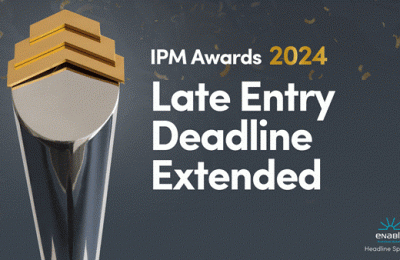With only seven days to go before the deadline for the IPM Awards 2017, Richard Pink provides some advice for people putting the final touches to their entries
As Head of Awards for the Institute of Promotional Marketing’s IPM Awards and COGS Awards, I’ve seen too many great campaigns fail at the first hurdle because of poorly-written entries.
As a result, work which is arguably less effective walks off with the trophies. That’s obviously frustrating for the agency and client responsible for brilliant campaigns which don’t win, but it’s also frustrating for the IPM.
We want to reward the best possible work, because we want to shout about how good promotional marketing campaigns can be at achieving client objectives – but our judges can only work with the materials they are given in the entries.
So I thought I’d take the opportunity to list some key things people get wrong when writing these entries; or, to put it more positively, to provide some top tips to ensure the best work gets recognised as such.
Spelling and grammar
As the man who spelt grammar ‘grammer’ last year in an article about spelling and grammar, you’d be write to think (I did that on purpose, by the way) that spelling and grammar don’t bother me that much.
However, they do bother a lot of our judges. Many of them are properly hacked off when they see poor spelling and grammar in award entry. It is such a simple thing to get someone who can properly proof read to look through your entry in the same way you would check and double check a pitch presentation. I know from experience it can make a difference if the judging is tight!
Provide the right information
I’ve seen too many entries that don’t give the judges enough information. The entrant wrongly assumes that the judges have the same level of knowledge about the campaign and its circumstances as the author of the entry does.
This has big implications for the way the entry is written; it can mean jargon starts creeping in that the judges may or may not be familiar with, but more problematic is the lack of context that will be given to the results.
The results may be phenomenal, but when you write an award entry you have to tell the judges why they are so good. My best advice on this is always the same – imagine trying to explain it to your Mum and you won’t go far wrong.
Wooly objectives and results
I’ve yet to see an entry where the results didn’t beat the objectives. It almost as if the objectives were worked out after the results were in – but that would never happen, would it?
That piece of unnecessary cynicism aside, my experience is that judges like to see clear results, and that requires clear objectives. They like percentages, numbers and stats; they don’t like ‘there was a substantial increase’ or ‘we drove awareness’ – you can hear them screaming ‘how much?’, ‘what was the increase?’ and ‘what was the target?’.
It’s true that sometimes you can’t get actual numbers because they aren’t measured or because they are confidential; but even in these circumstances you can give the judges a good indication of the success.
For example, “Normal expectations would be a 5-10% increase for this type of activity; although we can’t give actual figures, the rate achieved by this campaign was more than double this.” You’ve given numbers and context and probably made the judges very happy indeed.
Judges are busy people; make things easy for them!
Don’t get me wrong; people who asked to judge, by and large, are honoured to take the role on, and they take their role very seriously.
However, in the same way that the most difficult bit of going to the gym is actually walking through the door in the first place, the toughest bit of judging awards entries is actually picking up or opening the first entry – because you know it’s going to take time to do it properly.
So when you begin to craft your entry, try and be the judges’ best friend and make things as easy for them as possible.
Start by looking at the criteria that your entry is being judged against, and writing your entry to those criteria. It’s asking for 10% only on the creative? Then don’t write 500 words explaining how you made it look gorgeous if 50% of the marks are allocated to results.
Write your responses in the order the criteria are listed in, so it’s dead easy to follow.
Use bullet points – don’t try to embellish things, the poor weary judges won’t have the time or patience to read all the flowery prose you’ve added to make it read like Wordsworth wrote your entry.
If it was as good as you think it is, then it doesn’t need embellishing – just say it clearly and our judges will thank you.
A picture says a thousand words…
By all means, bring your entry to life with some visuals to show the judges how great the campaign was – a picture will always tell the story better than the words can.
Some campaign really benefit from a shorty video – experiential activations, for example – but don’t make it more than a couple of minutes long. When a judging panel has 25 entries to go through, the last thing the judges need is to be watching the awards equivalent of Ben-Hur.
Richard Pink is Head of Awards for the Institute of Promotional Marketing. The IPM Awards 2017 close on February 28th 2017 – for further information on categories and how to enter, go to the IPM website, www.theipm.org.uk

























